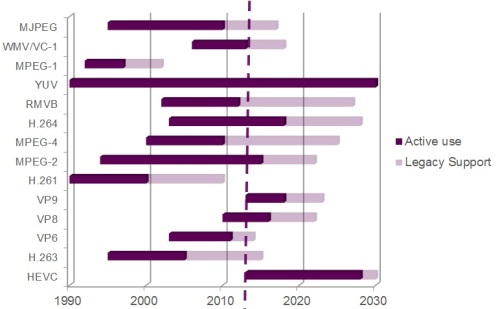Next-Generation Video Transcoding
To get some idea on what this means, the current HDTV Rec. 709 standard specifies the following X-Y coordinates for red, green and blue:
R(ed) = (0.640, 0.330); G(reen) = (0.300, 0.600); B(lue) = (0.150, 0.060)
These are specific coordinates for the locations of those colors as depicted by the smaller triangle on the chart in Figure 6. The color gamut described by these coordinates is reasonable, but certainly not as realistic as we experience in the real world; anything outside the triangle is not guaranteed to be captured by the camera, encoded on the disc, or accurately shown on your TV.

Fig. 6: A visual representation of Rec. 709 and BT.2020 standards**
Contrast this with BT.2020 that recommends coordinates of:
R = (0.708, 0.292); G = (0.170, 0.797); B = (0.131, 0.046)
These coordinates describe the larger triangle on the chart; this extends the range of colors to be captured and rendered on display devices.
The second aspect about how BT.2020 defines color is bit depth. The number of bits used to represent each color determines the range of shades one can generate. Current systems use 8 bits per color, resulting in 28=256 different shades for each primary color (red, green and blue, respectively). The current Rec. 709 standard can support a total of 16.78 million colors (256 R x 256 G x 256 B).
BT.2020 expands this range significantly by defining a minimum 10-bit color depth. By adding another two bits to each color representation, the number of overall possibilities increases to 1.07 billion (210=1024 x 1024 x 1024). This extended range has numerous advantages when representing a greater dynamic range between the lightest and darkest areas of a frame.
Why do we need multi-standard video transcoders?
For all the benefits offered by HEVC and VP9, the older standards cannot be abandoned. Vast amounts of digital content, professionally and consumer produced, will continue to exist for as long as the public plans to hold on to their DVD and Blu-ray collections!
Fig. 8: Video codecs in use today – why we need multi-standard video IP like PowerVR D5500
This means that multi-standard decode will always be a requirement.
Video with amazing clarity and depth
While 4K is available today only in some high-end implementations, this technology is coming soon to mainstream TVs. More and more 4K products will begin to enter the market as the content becomes available – driven by next-generation cameras with 4K capture capability, as well as new and traditional broadcast mechanisms. Imagination’s customers are already starting to build support for HEVC into their silicon with our complete video IP cores featuring 10-bit color depth support. With these technologies, tomorrow’s Ultra-HD products will provide amazing color and clarity for a brilliant consumer experience.



















